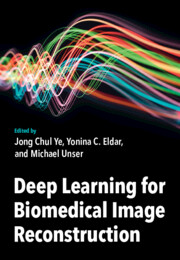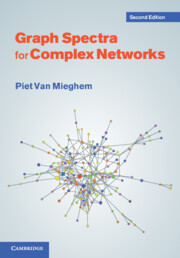Refine search
Actions for selected content:
6829 results in Communications and signal processing
Frontmatter
-
- Book:
- Graph Spectra for Complex Networks
- Published online:
- 07 September 2023
- Print publication:
- 21 September 2023, pp i-iv
-
- Chapter
- Export citation
Bibliography
-
- Book:
- Graph Spectra for Complex Networks
- Published online:
- 07 September 2023
- Print publication:
- 21 September 2023, pp 503-512
-
- Chapter
- Export citation
5 - Effective resistance matrix
- from Part I - Spectra of graphs
-
- Book:
- Graph Spectra for Complex Networks
- Published online:
- 07 September 2023
- Print publication:
- 21 September 2023, pp 175-192
-
- Chapter
- Export citation
Part III - Polynomials
-
- Book:
- Graph Spectra for Complex Networks
- Published online:
- 07 September 2023
- Print publication:
- 21 September 2023, pp 399-400
-
- Chapter
- Export citation
10 - Eigensystem of a matrix
- from Part II - Eigensystem
-
- Book:
- Graph Spectra for Complex Networks
- Published online:
- 07 September 2023
- Print publication:
- 21 September 2023, pp 345-398
-
- Chapter
- Export citation
Preface to the first edition
-
- Book:
- Graph Spectra for Complex Networks
- Published online:
- 07 September 2023
- Print publication:
- 21 September 2023, pp xiii-xv
-
- Chapter
- Export citation
3 - Eigenvalues of the adjacency matrix
- from Part I - Spectra of graphs
-
- Book:
- Graph Spectra for Complex Networks
- Published online:
- 07 September 2023
- Print publication:
- 21 September 2023, pp 51-110
-
- Chapter
- Export citation
6 - Spectra of special types of graphs
- from Part I - Spectra of graphs
-
- Book:
- Graph Spectra for Complex Networks
- Published online:
- 07 September 2023
- Print publication:
- 21 September 2023, pp 193-246
-
- Chapter
- Export citation
Preface to the second edition
-
- Book:
- Graph Spectra for Complex Networks
- Published online:
- 07 September 2023
- Print publication:
- 21 September 2023, pp xi-xii
-
- Chapter
- Export citation
12 - Orthogonal polynomials
- from Part III - Polynomials
-
- Book:
- Graph Spectra for Complex Networks
- Published online:
- 07 September 2023
- Print publication:
- 21 September 2023, pp 467-502
-
- Chapter
- Export citation
4 - Eigenvalues of the Laplacian Q
- from Part I - Spectra of graphs
-
- Book:
- Graph Spectra for Complex Networks
- Published online:
- 07 September 2023
- Print publication:
- 21 September 2023, pp 111-174
-
- Chapter
- Export citation
2 - Algebraic graph theory
- from Part I - Spectra of graphs
-
- Book:
- Graph Spectra for Complex Networks
- Published online:
- 07 September 2023
- Print publication:
- 21 September 2023, pp 15-50
-
- Chapter
- Export citation
Acknowledgements
-
- Book:
- Graph Spectra for Complex Networks
- Published online:
- 07 September 2023
- Print publication:
- 21 September 2023, pp xvi-xvi
-
- Chapter
- Export citation
Contents
-
- Book:
- Graph Spectra for Complex Networks
- Published online:
- 07 September 2023
- Print publication:
- 21 September 2023, pp vii-x
-
- Chapter
- Export citation

Deep Learning for Biomedical Image Reconstruction
-
- Published online:
- 15 September 2023
- Print publication:
- 12 October 2023

Graph Spectra for Complex Networks
-
- Published online:
- 07 September 2023
- Print publication:
- 21 September 2023
Part II - Universal Codes
-
- Book:
- Analytic Information Theory
- Published online:
- 24 August 2023
- Print publication:
- 07 September 2023, pp 189-190
-
- Chapter
- Export citation
6 - Nonprefix One-to-One Codes
- from Part I - Known Sources
-
- Book:
- Analytic Information Theory
- Published online:
- 24 August 2023
- Print publication:
- 07 September 2023, pp 91-103
-
- Chapter
- Export citation
5 - Khodak VV Codes
- from Part I - Known Sources
-
- Book:
- Analytic Information Theory
- Published online:
- 24 August 2023
- Print publication:
- 07 September 2023, pp 72-90
-
- Chapter
- Export citation
3 - Tunstall and Khodak VF Codes
- from Part I - Known Sources
-
- Book:
- Analytic Information Theory
- Published online:
- 24 August 2023
- Print publication:
- 07 September 2023, pp 35-55
-
- Chapter
- Export citation
